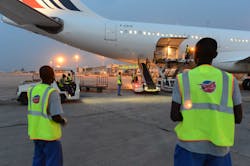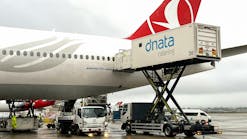The International Air Transport Association (IATA) develops industry standards for ground operations, and with the IATA Airport Handling Manual (AHM) and IATA Ground Operations Manual (IGOM), the organization has created “an encyclopedia” for the industry, which helps promote and drive global implementation of standards. These standards include policies and procedures covering passenger, baggage, ramp, cargo and mail handling, as well as technical specifications for GSE, automation on the ramp, minimum standards for ground ops frontline personnel training and more.
Irrespective of the airline or ground handler, or their location, standards ensure a global baseline and that the same, or similar, processes are taking place. IATA’s work to set standards is especially important because ground operations are not globally regulated, and within the industry, there are many complexities.
Iva Pluhackova, IATA head of operations and standards, gives examples of some of the complexities. Airlines, which are responsible for ground ops, subcontract 80 percent or more of handling to third-party ground handling service providers. Airlines are responsible for providing instruction on how to handle an aircraft and provide oversight of the ground handlers.
“It sounds clear and easy,” she says.
But it’s not. For example, if a ground handler provides service to 200 airlines, there would be 200 different manuals with specific airline procedures.
“If you take into account that those manuals are updated on a weekly or monthly basis, it becomes impossible to follow all updates, brief and train relevant personnel,” she says. It also becomes difficult to ensure every flight, which could be more than 200 a day, are handled according to a specific airline’s procedures, she adds.
Conversely, an airline that flies on average two times a day to 100 destinations might have 200 different handlers and 400 flights to monitor. The airlines need to ensure that all handlers receive updated manuals, acknowledge receipt of the manuals and implement the updates.
“So it is complex, but it does not have to be, nor should it be,” Pluhackova says.
Airlines are operating similar types of aircraft, flying to the same destinations and using the same ground handlers. Regardless of who owns or operates an aircraft, or where it is, it should be handled the same way, she says. Similarly, ground handlers should receive similar training, regardless of where or for whom they work.
The same applies to GSE technical specifications, she says. The GSE needs to fit various aircraft, meet certain technical and safety parameters, and where possible, should be operated in a similar fashion irrespective of the manufacturer or equipment type.
Who Benefits from These Standards?
When standards are in place, the entire industry benefits, she says, “by ensuring that we speak the same language globally and we have the same baseline globally.”
Pluhackova says the use of common industry standardization will promote effective utilization of similar skillsets among different carriers; ease the return to service; minimize safety and security events; and provide effective and cheaper oversight of safe operations.
“Additionally, IATA standards do not only ensure that we have the same standards for the operations, training and contracts, equipment, etc. but we have also the same standards used for the auditing,” she says.
The IATA Safety Audit for Ground Operations (ISAGO) is designed to verify the implementation of AHM and IGOM within companies’ operations.
Adopting IATA Standards
“IATA is not a regulator therefore our standards are not mandatory per say,” Pluhackova says. “Nevertheless, as an airline association, we develop standards, rules and guidelines for our members.
“The IATA resolutions developed under the traffic conferences are the highest level of our standards and are binding to our members.”
The recommended practices (RP) are the second level, and members can choose to adopt them on voluntary basis. The AHM, IGOM and Baggage Reference Manual (BRM) are recommended practices developed under the Passenger Service Conference (PSC RP).
“Our members also contractually require that their providers follow the ground operations standards via Standard Ground Handling Agreement (SGHA),” she adds.
In addition, IATA produces various guidance, positions papers and analytical reports for industry knowledge.
The AHM and IGOM are based on industry knowledge and current best industry practices. Pluhackova describes their implementation as organic and says they are adopted for their value. Based on an annual IATA publications survey, 90 percent of AHM/IGOM users are satisfied with the content and see the manuals as a primary source of information, which they use to create company procedures.
“It helps them to improve, standardize and validate their policies and procedures as well as ensure that the airlines and their providers speak the same language,” she says.
Survey respondents also found the publications to be a valuable source for training and ISAGO accreditation.
“We are also advocating with regulators to recognize AHM [and] IGOM and consider them as an acceptable means of compliance in the jurisdiction where the regulation for ground ops exists such as EASA,” she says.
Working Groups
IATA standards are developed under the Passenger Standard Conference (PSC) and Travel Standard Board (TSB), including smaller groups like the Ground Ops Automation and Digitalization (GAD), Ground Ops Standards (GOS), Baggage Working Group (BWG) and Baggage Steering Group (BSG).
“We have very well-defined governance structure for ground operations within IATA,” Pluhackova says.
Working groups have a delegated responsibility to approve AHM and IGOM changes in their area of expertise.
There are also other groups and subject matter experts contributing to the development of the AHM, such as the ULD Board, Security Working Group and Cargo Handling Oversight Committee.
“Ground ops groups consist of a pool of experts in various subject matters,” Pluhackova says. “Groups are organized into sub-groups based on the operational area and standards, which need to be developed. The expertise required is driven by the IATA ground operations priorities and objectives for the group tenure. We hold monthly or more frequent calls, at least one face-to-face meeting for every sub-group. The group participants are developing standards directly by themselves, or IATA external or internal experts prepare drafts, which the group reviews and amends to the final version.”
The GOS plays a key role in the AHM/IGOM development as they oversee four AHM chapters and the majority of the IGOM.
For 2023 there are four sub-groups within the GOS:
- Organization and Safety
- Training
- Operations
- Contracts
“This groups include airlines representatives, ground handling providers and industry partners,” Pluhackova says. “Each participant has a deep knowledge and experiences in the ground ops but most importantly, incredible enthusiasm and passion for our industry. I am truly honored to be the secretary of this group and together with my standard team, we will never stop to be amazed by amount of work, ideas and improvements our members bring to the table. It keeps us motivated.
“Some of them are participating in our groups for years, and we have developed friendship over those years,” she continues. “Our members provide a lot of their time and work, and in return, they expect full support from our team, and we cannot disappoint them.”
The GAD has established four sub-groups:
- Load Control and Aircraft Messages
- GSE (autonomous, green, management)
- Digital Ramp
- Delay Codes
Similar to the GOS, the GAD consists of airlines, ground handlers and manufacturer subject matter experts. The GAD takes care of the updates of the aircraft messages and load control in the AHM and IGOM.
Baggage standards are developed by the BWG and the BSG. Industry experts with subject matter knowledge on the different baggage operational areas work toward developing common standards and best practices for an efficient and cost-effective baggage handling process. The BSG plays a more strategic role in defining the work plan and priorities of the baggage working group, while the BWG ensures the delivery of the actual work plans by its various sub working groups reporting to it.
The Process for Creating Standards
The objectives for creating IATA standards come from multiple parties.
The ground ops objectives come from various sources, while IATA’s strategic objectives come from its Board of Governors.
“Strategic objectives for ground ops are shaped by the Ground Operations Group (GOG), which reports to the Operations Advisory Council and provides to IATA management where we should focus via IATA initiatives, standards or advocacy,” Pluhackova says. “GOS, GAD, BWG, BSG are providing input to the standards development, we are doing an analysis of the data available in the IATA Accident Database (IDX) for the most frequent and serious aircraft damages, loading errors and injuries.
“We have also started to have some data in the IGOM portal, specifically the IGOM provisions, where is the most airlines variations, and we will analyze them and prepare the plan how to reduce them,” she continues. “And last but not least, and of the most valuable feedback is directly for our manuals’ users.”
Once input from ground handling-focused working groups is gathered, it factors into IATA’s process for developing standards.
“Objectives, input, all submissions are reviewed by IATA secretaries, who create the work plan,” Pluhackova says. “This is then reviewed and agreed by the ground ops groups, and groups work on the standards development or updates during the year. The expert groups work on the amendments, proposed changes are open to the various IATA groups based on the topic, comments are reviewed and addressed if relevant.”
The final draft is then voted as per IATA governance, and finalized updates are then handed in for publication.
“It is fairly cumbersome process as we produce four manuals in printed and digital versions, including French and Spanish versions for the IGOM,” Pluhackova says, noting production of the manuals take on average 3 months each.
The working groups have two-year mandates. IATA called for nominations in February for tenure 2023-2025, and groups started work in March. GOS/GAD groups are open to IATA members and IATA ground handling partners and strategic partners for the ground ops area. BSG/BWG is open to IATA members and strategic partners for baggage area.
“We also cooperate with the industry organizations such as Society of Automotive Engineers (SAE), Airport Council International (ACI), Airport Services Association (ASA), ISO and others,” Pluhackova adds.
“As we start our groups’ work, there might be need for a specific interest and we will approach our industry to fill the gaps. We always need more airlines to participate in Ground Ops Automation and Digitalization. We want to know what our members are doing in these areas.”





